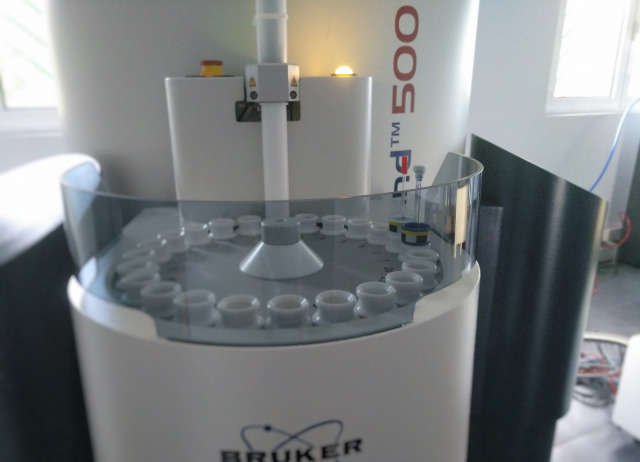Nuclear Magnetic Resonance
Nuclear Magnetic Resonance is a spectroscopic technique that provides structural and stereochemical information of great interest in a very short time.
The Nuclear Magnetic Resonance Service (NMR) is fundamentally dedicated to the structural determination of both organic and inorganic compounds. The technique is non-destructive and has applications in numerous areas of Chemistry and in some areas of Biology. The detailed analysis of obtained spectra provides valuable structural and stereochemical information and, in addition, allows certain studies to be carried out in both kinetics and molecular dynamics.

Type of Analysis
Nuclear magnetic resonance is a spectral method based on the magnetic properties of atomic nuclei. If it only involved nuclei, it would not be of interest to chemists. Fortunately, electrons will produce modifications, weak but observable, these being the ones that will give rise to chemical displacements and coupling constants, thus allowing the detailed study of the electronic structure of molecules, the reason for the success of NMR in organic chemistry.
The fields of application of this technique are diverse:
- Structural elucidation of compounds with magnetically active nuclei (1H, 13C, 31P, 19F and 15N).
- Identification and quantification of organic compounds, organometallic, etc.
- ReceptorLigand interaction studies.
- Structural and stereochemical analysis.
- Obtaining kinetic parameters of chemical reactions.
- Study of dynamic systems.
- Study of physical parameters of molecules.
Requirements
Dissolved samples will be delivered to the service in a closed tube and properly labelled. Samples must be properly labelled indicating solvent, experiments to be carried out, and user or research group to which it belongs.
In those cases in which the sample is unstable under ambient temperature conditions, the user must inform the service personnel of this circumstance in order to take the appropriate measures.
The user of this service will be provided with the technician's e-mail address and telephone number, for any queries they may have.
Measurement parameters
- Obtaining NMR spectra in solution of 1H (400 and 500 Mhz), 13C, 31P, 19F and 15N (at the corresponding frequencies according to the instrument).
- Mono and twodimensional experiments (mono and heteronuclear correlations).
- Variable temperature experiments.
Equipment
- Multi-nuclear NMR spectrometer (Bruker Avance II-500).
- Multi-nuclear NMR spectrometer (Bruker Avance 400).
- High sensitivity cryoprobes for NMR samples in solution.
- QNP probes (1H, 13C, 31P, 15N y 19F).
- Variable temperature accessory.
How can I request a service?
Contact us!
info [at] ipna.csic.es (Contact us!)